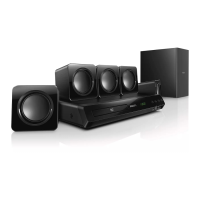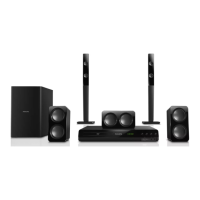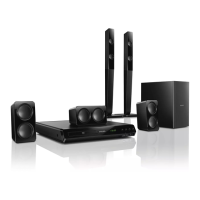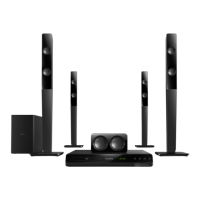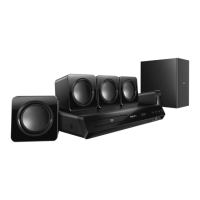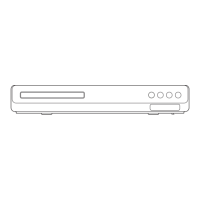Do you have a question about the Philips HTD5520 and is the answer not in the manual?
Essential safety instructions and warnings for operating the home theater to prevent electrical shock, fire, and injury.
Guidelines for cleaning and maintaining the home theater to ensure its longevity and optimal performance.
Information on responsible disposal of the product and batteries to minimize environmental impact.
Overview of the main home theater unit, including its physical components and front panel display.
Detailed explanation of the remote control's buttons, functions, and navigation for operating the system.
Identification and description of all input and output connectors available on the home theater system.
Guidance on connecting speakers, including optimal placement for surround sound effects.
Instructions for connecting the home theater to a TV using various connection types like HDMI and composite video.
Steps to connect audio from external devices like TVs or other sources using analog or digital cables.
Details on setting up speakers, configuring HDMI-CEC (EasyLink), and audio output.
Instructions for playing various disc formats and digital files from USB or discs.
Guides on synchronizing audio-video, selecting subtitles, and using DivX video features.
Details on connecting Bluetooth devices, USB storage, and accessing advanced media playback settings.
Instructions for tuning radio stations, using karaoke features, and selecting sound modes.
Adjusts display settings like video format, resolution, aspect ratio, and picture enhancements.
Set preferred languages for onscreen menus, audio tracks, and subtitles on discs.
Customize audio settings including HDMI audio output, speaker setup, and sound modes.
Manage playback restrictions, lock discs, configure display/energy saving, and restore defaults.
Procedure to check the current software version installed on the home theater.
Step-by-step guide to download and install software updates using a USB flash drive.
Lists supported video and audio file formats, codecs, and disc region code compatibility.
Technical specifications for Bluetooth, amplifier output, video output, and audio inputs.
Specifications for radio tuning, USB compatibility, power supply, unit dimensions, and laser type.
Resolves problems with unresponsive buttons, lack of picture, or HDMI connection errors.
Addresses issues like no sound, distorted audio, or audio-video sync discrepancies.
Solutions for disc/file playback errors, subtitle display issues, EasyLink, and Bluetooth problems.
Information regarding copyright protection technology and intellectual property rights.
Details on Dolby, DivX, HDMI, and Bluetooth trademarks and their usage.
Essential safety instructions and warnings for operating the home theater to prevent electrical shock, fire, and injury.
Guidelines for cleaning and maintaining the home theater to ensure its longevity and optimal performance.
Information on responsible disposal of the product and batteries to minimize environmental impact.
Overview of the main home theater unit, including its physical components and front panel display.
Detailed explanation of the remote control's buttons, functions, and navigation for operating the system.
Identification and description of all input and output connectors available on the home theater system.
Guidance on connecting speakers, including optimal placement for surround sound effects.
Instructions for connecting the home theater to a TV using various connection types like HDMI and composite video.
Steps to connect audio from external devices like TVs or other sources using analog or digital cables.
Details on setting up speakers, configuring HDMI-CEC (EasyLink), and audio output.
Instructions for playing various disc formats and digital files from USB or discs.
Guides on synchronizing audio-video, selecting subtitles, and using DivX video features.
Details on connecting Bluetooth devices, USB storage, and accessing advanced media playback settings.
Instructions for tuning radio stations, using karaoke features, and selecting sound modes.
Adjusts display settings like video format, resolution, aspect ratio, and picture enhancements.
Set preferred languages for onscreen menus, audio tracks, and subtitles on discs.
Customize audio settings including HDMI audio output, speaker setup, and sound modes.
Manage playback restrictions, lock discs, configure display/energy saving, and restore defaults.
Procedure to check the current software version installed on the home theater.
Step-by-step guide to download and install software updates using a USB flash drive.
Lists supported video and audio file formats, codecs, and disc region code compatibility.
Technical specifications for Bluetooth, amplifier output, video output, and audio inputs.
Specifications for radio tuning, USB compatibility, power supply, unit dimensions, and laser type.
Resolves problems with unresponsive buttons, lack of picture, or HDMI connection errors.
Addresses issues like no sound, distorted audio, or audio-video sync discrepancies.
Solutions for disc/file playback errors, subtitle display issues, EasyLink, and Bluetooth problems.
Information regarding copyright protection technology and intellectual property rights.
Details on Dolby, DivX, HDMI, and Bluetooth trademarks and their usage.
| Satellite speakers RMS power | 166 W |
|---|---|
| Satellite speaker frequency range | 150 - 20000 Hz |
| Center speaker mid-range driver diameter | 1 \ |
| Subwoofer type | Passive subwoofer |
| Subwoofer frequency range | 20 - 150 Hz |
| FM radio | Yes |
| Supported radio bands | FM |
| AC input voltage | 220-240 V |
| AC input frequency | 50 Hz |
| Power consumption (standby) | 0.5 W |
| Package weight | 11220 g |
| Quantity | 1 |
| Battery type | AAA Battery |
| Image formats supported | BMP, GIF, JPEG XR, TIF |
| Video compression formats | DivX, MPEG1, MPEG2 |
| MP3 bit rates | 32 - 320 Kbit/s |
| Audio decoders | Dolby Digital 5.1 |
| RMS rated power | 1000 W |
| Audio output channels | - channels |
| Audio formats supported | MP3, WMA |
| Total Harmonic Distortion (THD) | 10 % |
| Product color | Black |
| Disc types supported | CD, CD-DA, CD-R, CD-RW, DVD, DVD+R, DVD+RW, DVD-R, DVD-RW |
| Playback disc formats | SVCD, VCD |
| Optical disc player type | - |
| Video formats supported | AVI, DIVX, MPEG, MPG |
| HDMI version | 1.4 |
| Cables included | HDMI |
| Subwoofer weight | 4300 g |
|---|---|
| Center speaker weight | 650 g |
| Subwoofer dimensions (WxDxH) | 233 x 310 x 365 mm |
| Front speaker dimensions (WxDxH) | 90 x 82 x 185 mm |
| Center speaker dimensions (WxDxH) | 223 x 80 x 100 mm |
